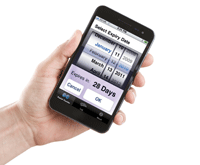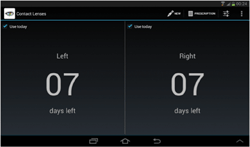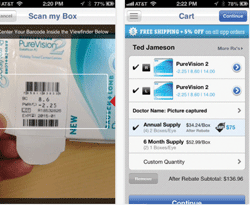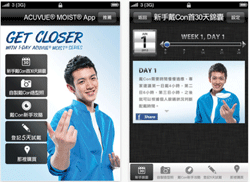The consumer trend toward mobile technology continues unabated.
According to a June 5, 2013 report, 56% of American adults are now smartphone owners. To the practicing optometrist, it is unknown what implications the rapid consumer adoption of mobile technology portends.

Here is what we currently know about the smartphone market: The leading operating system (by market share) for all smartphones is Android, ahead of Apple’s iOS.
During the second quarter of 2013, worldwide smartphone shipments were 79.3% Android and 13.2% iOS. Here in the United States, Android has approximately a 50% market share, with iOS around 40%. The recent release of new iPhone models just last month may help iOS gain on Android.
Despite its smaller share, the iOS platform remains the first-tier priority for most app developers because Apple’s smaller, more standardized product line makes it easier to release new software without having to create multiple iterations of the same app. The Android device family is far more diverse—and, thus, harder to support.
It’s no secret that smartphone apps have attained immense popularity in recent years. Everything from gaming to balancing finances can be done on your smartphone via an ever-growing library of apps.
But what about contact lens care? In this article, we review the use and implications of smartphone apps in optometry, and give our best projections for the future of apps for contact lens wearers.
Appetite for Apps
According to a March 2012 comScore report, approximately 80% of mobile media time is spent using apps, with the remainder of time spent using a web browser.
The caveat in interpreting this statistic is that the internet lives within most apps. That’s to say, many users spend significant time using interactive gaming and social networking apps, each of which access the internet to provide their core functions.
While the majority of time on mobile devices is spent using such apps, it is still worth examining and understanding the available contact lens apps geared toward consumers for the Android and iOS platforms.

1. A screenshot of the "Contact Lenses" app for Android.
A survey of the available Android apps for contact lenses shows that several options for users exist, but none been able to achieve an install volume above 10,000 to 50,000 users thus far.
These numbers are not encouraging, and represent very low market penetration. The figures are curious, considering the increasing number of smartphone users, and the fact that there are 125 million contact lens wearers worldwide.
The iOS apps for contact lenses show a similar pattern. Most of these apps have relatively few user ratings—a statistic that suggests a low number of total installations
After reviewing a majority of the contact lens apps, two major functional categories are consistent: a contact lens replacement counter and the ability to shop for new and replacement lenses. Below, we review apps that represent these functions. The majority are free to download, with some that require purchase.
Contact Lens Replacement Counters
Several apps share a feature that counts down the days until the contact lenses are to be replaced. Some of these apps include the following options for the Android operating system: “Contact Lenses” (Figure 1), “forEyes,” “Contact Lens Timer Free” and “Contact Lens Counter.” A comparable app for iOS is “Contact Lens Tracker."
The majority of these apps are simple in design, offering intuitive, user-friendly interfaces. Some allow skipping days, price comparison, storing the prescription and prescribing doctor information. Surely, there are many users who find these features helpful.
If these features are so useful, why have there been so few installations of these apps, especially when the majority are free to download?
Several factors contribute to the relatively low demand for apps that provide contact lens replacement counters.
On one hand, the number of patients wearing single-use contact lenses is on the rise, estimated at 17% of contact lens prescriptions in 2012 in the United States. Due to the nature of the modality, it is unlikely that single-use contact lens wearers need a daily reminder to replace their contact lenses.
Second, for other lens replacement frequencies it is widely known that patient adherence to the recommended replacement schedule is poor. Relatively few users seek an app that reminds them to replace their contact lenses due to a very low intrinsic value to replace lenses as scheduled.
Finally, it is possible that a smartphone user who really wants a reminder app will more likely install a more generic app which provides reminders for a broad range of categories, such as paying bills, birthdays of friends and family, taking medicine and so on.

2. A screenshot of the "1-800-CONTACTS" app.
As most smartphones come with some sort of “reminder” app built in, the need to download one solely for contact lens replacement diminishes greatly.
By itself, contact lens replacement is a low-impact decision for most consumers. Because of this, it does not compel most wearers to download a specific app designed solely for that purpose.
While these apps aren’t very popular, general reminder apps are downloaded far more often. For example, over 500,000 smartphone users have downloaded “Life Reminder,” a general reminder app that alerts users to perform a multitude of tasks. In comparison, none of the contact lens reminder apps for Android has exceeded more than 50,000 downloads.
Although reminder apps designed specifically for contact lens replacement haven’t experienced much consumer popularity, Vistakon has had some success in getting contact lens wearers to sign up for free e-mail alerts or text message reminders to replace contact lenses. The company recently has promoted corresponding apps in Canada for the iPad, iPhone and Android devices.
Overall, it seems that contact lens users don’t seek electronic reminders for lens replacement in great numbers out of some combination of lack of awareness, lack of need or duplication of function in other apps.
Contact Lens Shopping
Several contact lens apps also include a feature that allows users to shop for lenses directly through the phone. For example, the Android app “Contact Lens Counter” takes the user to a price comparison page on the website,
www.contactlensprices.com.
The app for 1-800-CONTACTS (Figure 2), available for both Android and iOS, comes equipped with a barcode scanning ability that can be used to determine the contact lens directly from the barcode on the box, allowing the user to easily order the same lenses directly from 1-800-CONTACTS.
In the case of Contact Lens Counter, the pricing for Acuvue Oasys lenses are shown from a number of sites, including, Vision Direct, AC Lens and Discount Contact Lenses. The 1-800-CONTACTS app only provides their pricing. The 1-800-CONTACTS app also includes a counter for lens replacement, a doctor search within their endorsed network and order tracking.
While the 1-800-Contacts app for Android has between 10,000 and 50,000 installations, the Google Goggles app has over 10 million downloads. When a box of contact lenses is scanned with Google Goggles, a full Google search is performed for the detected text, which yields a much larger number of online contact lens vendors selling the product.
The discrepancy is due to the Google Goggles having potential use for just about any product, whereas the 1-800-Contacts scanner is only relevant for contact lenses barcode scanning.

3. The "AcuVue Moist" app for the Hong Kong market, available for iOS.
Company Branding and Education
Aside from Vistakon and its Acuminder mobile apps, there have been only sparse attempts by other manufacturers with app-based efforts directed at the consumer.
But options outside of Vistakon do exist.
For example, Alcon offers patients its “Lens Facts from Opti-Free Brand” app, available on iOS. This app provides a contact lens replacement tracker, a log for contact lens comfort and information about contact lens wear and care. More information can be found at
www.ideo.com/work/lens-facts-iphone-app/. There is a FAQ section with answers to common questions, such as whether or not is it OK to use cheaper store-brand solution, to wear a friend’s contact lenses, and so on. The information available in the app is displayed in a variety of ways, including videos.
For the Hong Kong market, Johnson & Johnson has an app specific for promoting Acuvue Moist (Figure 3). Aside from Johnson & Johnson’s offering, there seems to be a general absence of promotional apps for specific brands of contact lenses.
Summary Impressions
When matched against popular apps such as Google Maps, Facebook and Angry Birds, those that specifically target contact lens users are relatively unpopular when looking at their total number of installations. But this fact really shouldn’t come as much of a surprise to us.
We generally believe that a contact lens wearer using a smartphone is more likely to use a common app, such as LifeReminder or Google Goggles, and adapt it for contact lens use. This suggests that apps that are more broad-based have a higher likelihood for use by contact lens users.
Based on the experience and statistics thus far, it does not seem likely that mobile apps are the answer to improving patient adherence to scheduled lens replacement schedules.
While the application of smartphone apps for compliance may not be viable, online contact lens companies may employ apps as a means to offer a way to facilitate lens purchase. There may be some potential for apps in patient education and product promotion, but this employment of apps has remained unexplored.
1.
http://pewinternet.org/Reports/2013/Smartphone-Ownership-2013/Findings.aspx
2.
http://techland.time.com/2013/04/16/ios-vs-android/
3.
http://www.smartinsights.com/mobile-marketing/app-marketing/82-of-mobile-media-time-is-via-apps/
4.
http://www.ncbi.nlm.nih.gov/pubmed/17975417
5.
https://play.google.com/store/apps/details?id=com.blogspot.kurinapps.lenses&hl=en
6.
https://play.google.com/store/apps/details?id=com.blogspot.kurinapps.lenses&hl=en
7.
https://play.google.com/store/apps/details?id=com.conod.apphealth.ContactTimer&hl=en
8.
https://play.google.com/store/apps/details?id=com.data.contactlenscounter
9.
https://itunes.apple.com/us/app/contact-lens-tracker/id363853333?mt=8
10.
http://www.clspectrum.com/articleviewer.aspx?articleID=107853
11.
http://www.clspectrum.com/articleviewer.aspx?articleid=13187
12.
https://play.google.com/store/apps/details?id=com.payneservices.LifeReminders&hl=en
13.
http://www.prnewswire.com/news-releases/acuminder-tool-helping-to-change-contact-lens-wearing-behavior-survey-shows-115090899.html
14.
http://www.acuvue.ca/sites/default/files/content/ca/pdf/ACU%20Acuminder_App_PDF_EN.pdf
15.
https://play.google.com/store/apps/details?id=com.google.android.apps.unveil&hl=en
16.
https://itunes.apple.com/us/app/lensfacts-from-opti-free-brand/id450251400?mt=8
17.
https://itunes.apple.com/us/app/acuvue-moist/id432834723?mt=8
18.
http://en.wikipedia.org/wiki/List_of_most_downloaded_Android_applications


